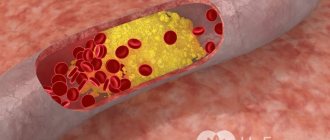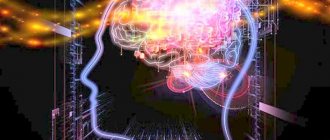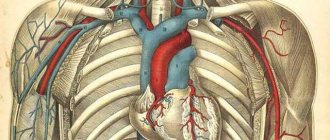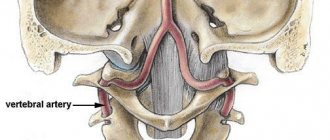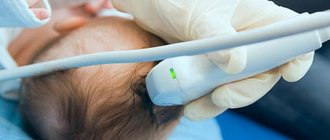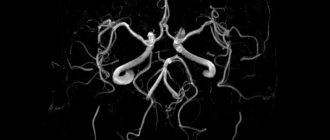Atherosclerosis of the cerebral arteries is the most common vascular pathology.
Blood flow to the cerebral vessels is provided by several main arteries:
- Brachiocephalic main arteries and brachiocephalic trunk;
- The common carotid artery and its branches are the internal and external lines;
- One branch of the LPA is the left-sided subclavian vessel;
- Vertebral main artery and internal mammary vessel.
Main sclerosis is a pathology of the main blood flow lines of the head, as well as the neck and extremities, which is associated with a narrowing of the main lumens due to the formation of atherosclerotic tumors in them and the appearance of blood clots.
Most often, main atherosclerosis of the head (MAC) develops.
This pathology has a chronic stage of the pathology with fairly frequent relapses, which can lead to ischemic type transient attacks and cerebral stroke.
Main sclerosis is a pathology of the main blood flow routes of the head
Development of atherosclerosis of the intracranial and extracranial parts
Atherosclerosis is a narrowing of the lumen of an artery due to the growth of a plaque in it, consisting of low-density cholesterol, calcium molecules, and the plaque is covered with medial fibrous tissue on top.
This vascular pathology leads to impaired blood velocity in the main arteries and insufficient blood supply to the organs, which leads to oxygen starvation of the organs (hypoxia).
Atherosclerotic neoplasms can grow in the extracranial segments of the arteries of the head, as well as in the intracranial arteries (intracranial vessels).
The extracranial level is sclerosis of the thoracic and cervical arteries, which provokes a lack of blood in all parts of the brain. The intracranial level is hypoxia of one of the parts of the brain that does not receive blood from the damaged intracranial vessel due to sclerosis.
As a result of the impaired quality of blood flow in the brain, blood clots accumulate in the basal ganglia, as well as in different parts of the cerebral cortex, which leads to thrombosis.
Consequences of thrombosis of the cerebral arteries:
- Necrotic lesions on brain cells;
- Scarring of brain cells and the development of cysts on it;
- Dystrophy and death of neurons, which reduce a person’s intellectual ability and leads to dementia.
Main cerebral atherosclerosis is a rather dangerous pathology that can be fatal.
All main lines supplying blood to the cerebral arteries originate from the aorta, so atherosclerosis of the aorta can also significantly disrupt the blood supply to the main lines, and the brachiocephalic trunk does not supply the required amount of blood to the cerebral arteries.
Main cerebral atherosclerosis is a rather dangerous pathology.
Symptoms
Atherosclerosis of extracranial segments of arteries is characterized by intense symptoms. The symptoms of the disease are influenced by the location of the pathology.
Symptoms of atherosclerosis of the great arteries include:
- Noise in ears.
- Sudden attacks of dizziness.
- Headaches of a compressive nature. The strength of the pain syndrome is determined by the stage of atherosclerosis, the degree of occlusion, and the location of the cholesterol plaque.
- Rapid memory deterioration. Short-term memory is especially affected. The patient quickly forgets what was just said and events that happened recently. A person forgets the simplest words. Long-term memory deteriorates in the late stage of atherosclerosis of the great arteries.
- Impaired movement coordination.
- Lack of clarity of speech, impaired diction.
- Night sleep disturbances. The patient is unable to sleep for a long time and often gets up in the middle of the night. During the day, a person feels tired and drowsy.
- The appearance of dark spots before the eyes. The patient can see them both before open and closed eyes.
- Hand tremors.
- Behavioral disorders. Patients experience depression, tearfulness, a tendency to sudden mood swings, unmotivated anxiety, suspicion, and demandingness. The patient's mental state is unstable: the person gets irritated or upset over the most insignificant reasons.
Atherosclerosis of the brain vessels often spreads further, including to the legs. In this case, the symptoms are supplemented by the following signs:
- Reduction of pulse in the lower extremities.
- Rapid fatigue during physical activity. A person gets tired especially quickly from walking long distances.
- Cold hands. They may show small ulcers.
- In the later stages of the disease, skin lesions can develop into gangrene.
- When the vessels of the legs are damaged, lameness occurs.
- Thinning of nails.
- Hair is falling out on the legs.
When you first suspect atherosclerosis, you should immediately consult a doctor. The doctor will conduct diagnostic measures and, if necessary, prescribe treatment.
to the point ↑
Causes of pathology
The etiology of the development of sclerosis of the main arteries of the brain is quite extensive and is associated with the age and gender of the patient, his hereditary predisposition.
The most common reasons:
- Hypertension with a long-term and stable increase in blood pressure index;
- Increased cholesterol index and imbalance between high-density lipoproteins, low-density lipids, as well as the level of triglycerides in the blood;
- Alcohol addiction in the chronic stage, causing hypertension and systemic atherosclerosis;
- Nicotine addiction - blood vessels lose strength and elasticity under the influence of nicotine, which leads to injury to the endothelium, on which plaques form;
- Obesity;
- Pathology diabetes mellitus;
- Pathologies of the cardiac organ;
- An inactive lifestyle, which contributes to cholesterol buildup in the bloodstream, because with physical inactivity the speed of blood flow decreases and blood clots form;
- Lack of culture in nutrition. Excessive consumption of fatty and fried foods, as well as a passion for fast food;
- Congenital anomalies of the branch of the aorta, as well as anomalies of the branching of the brachiocephalic trunk and the structure of the carotid arteries.
Obesity can cause the development of atherosclerosis of the great vessels of the brain
Brachiocephalic ducts
The brachiocephalic trunk is part of the branching of the aorta, which is a large main artery in the bloodstream.
The branches of the brachiocephalic trunk supply blood to the right side of the brachial section of the large vessels:
- Right subclavian main artery;
- Right-sided carotid main artery;
- Right-sided vertebral great vessel.
It is very important to pay attention to the development of the brachiocephalic main arteries, due to the fact that they are the main channel for supplying blood to brain cells.
With the development of atherosclerosis of the main course, the pathology of dementia can develop in the brain and lead to a stroke.
Quite often, a cerebral hemorrhage ends in the death of a sick person.
There are two types of atherosclerotic lesions of the brachiocephalic arteries.
The type of pathology depends on the size of the vessel lesion:
- Non-stenotic type of atherosclerosis of BCA;
- Stenotic lesion of the BCA.
With severe development of atherosclerosis of non-stenosing sclerosis in the brachiocephalic arteries, the atherosclerotic spot can occupy most of the lumen and lead to clogging of the artery.
The stenosing type of atherosclerosis of the BCA is a severe pathology in which the process of growth into the lumen proceeds quite quickly, which can quickly lead to occlusion of the line and death.
Atherosclerosis of the brachiocephalic highways of the brain
Systemic atherosclerosis of the internal carotid arteries
Depending on the clinical manifestations in the carotid great vessels, atherosclerosis is divided into:
- Stenosing type of main sclerosis of the carotid vessels - the lumen of the carotid artery is reduced by more than 50.0%. Treatment is only surgical;
- Non-stenotic type of main atherosclerosis of the carotid vessels - the lumen of the artery is reduced by less than 50.0%. Treatment with medications for a long period of time;
- Multifocal type of main sclerosis on the carotid arteries . This pathology is treated depending on the state of functioning of parts of the brain.
Ischemic strokes or cerebral infarctions lead to death in 5.0% of patients with atherosclerosis on the carotid great vessels.
The danger of the formation of atherosclerotic tumors in the carotid arteries is that platelet molecules adhere to the endothelial layer damaged by sclerosis and form a blood clot, which can enter the brain vessels through the main channel and lead to a stroke.
Atherosclerosis of the great vessels of the brain: features of pathology
Vascular lesions can be different, but the most dangerous of them is atherosclerosis of the great vessels of the brain.
This is not only dangerous, but also a common disease. Atherosclerosis is a chronic disease. The onset and deterioration of the great vessels occurs long before the crisis occurs. In many cases, people do not even suspect that they have problems with cerebral circulation until the first symptoms of the pathology begin to appear.
The essence of pathological processes in atherosclerotic damage to blood vessels is manifested in the appearance of cholesterol deposits on their walls, and then entire cholesterol plaques. This leads to stenosis of cerebral vessels and disruption of blood circulation and nutrition of various parts of the brain, depending on the location of the blockage.
Causes of atherosclerosis
The disease has a whole host of factors that provoke the leading cause of atherosclerosis – the occurrence of cholesterol deposits.
These factors include: the appearance of persistent hypertension, heart and vascular diseases, alcohol abuse, tobacco smoking, high levels of lipids in the blood, diabetes mellitus, excess body weight, physical inactivity, high levels of stress, bad eating habits, disruption of the endocrine glands, age factor.
Pathogenesis processes
Atherosclerosis of the cerebral vessels of the brain is more common than damage to blood vessels located outside the cranium. This occurs due to the structural features of the blood vessels in the brain.
The walls of the cerebral arteries of the head are much thinner than those of other arteries, so here atherosclerosis progresses more rapidly and affects large areas.
Cholesterol deposits that form in different parts of the main arteries also have their own characteristics. For example, atherosclerosis of the extracranial segments of the main arteries of the head is characterized by fibrous and stenotic neoplasms.
In the great vessels, plaques contain fewer lipid units and more collagen, while carotid plaques have approximately the same level of collagen and fat inclusions.
If the integrity of plaques containing a lot of lipids is damaged, there is a high risk of their rupture or complete separation from the vessel wall. This threatens the development of: coronary heart disease, atherothrombotic stroke, thromboembolism.
With some injuries, plaques threaten the appearance of hemorrhages or disruption of the integrity of the vessel. This usually happens with a strong systolic stroke of blood flow.
Signs of pathology
When atherosclerosis of the cerebral arteries occurs, a person develops accompanying symptoms. Patients do not identify the first signs with vascular problems, and therefore at the initial stage of development of the disease they do not pay attention to the pathology, which leads to aggravation of symptoms.
Signs of the disease include:
- the appearance of severe headaches, attacks of weakness and dizziness . At the same time, the headache is typical, attacks, it can appear at any time, regardless of the time of day or night. The severity of dizziness also varies - from mild malaise to loss of consciousness;
- tinnitus – uncomfortable sensations appear and disappear, and can intensify when tilting the head, during attacks of headaches and dizziness;
- constant weakness - it causes rapid fatigue, a feeling of irresistible drowsiness that persists throughout the day. Patients suffer from insomnia and often wake up;
- if atherosclerosis of the cerebral vessels affects the extracranial level of the arteries, then people may even suffer short-term amnesia ;
- emotional disorders - patients become too tearful or passive, they are tormented by anxiety, fears, and suspicion;
- neurological abnormalities , manifested in behavioral disorders, problems with movements.
Stages of atherosclerosis
The World Health Organization has developed a classification of the disease, according to which three stages of development can be distinguished.
The first stage of atherosclerosis is magic. vessels is characterized by minor disturbances. This is called the lipid spot stage. Lipid stains, as a rule, do not manifest themselves in any way, so patients do not even suspect such disorders.
If you look at a spot under a microscope, it may look like a strip or a round dot that rises only slightly above the surface, and sometimes even merges with it completely.
It is noteworthy that lipid stains can also be detected in children under one year of age, however, they subsequently resolve and do not indicate pathology.
The second stage is called fibrous plaque. In this case, cholesterol deposits do not simply appear on the wall of the artery, but significantly protrude from its wall into the lumen of the blood vessel.
This disorder can already be classified as a disease.
Externally, the plaques are light-colored deposits - from white to yellow with a pearlescent sheen. They have an oval or round shape, different heights and lengths along the vessel. Inside, such a plaque contains a certain amount of lipids, but the surface is covered with a fibrous or collagen membrane.
If such a plaque covers up to 60 percent of the lumen of the vessel, then no health problems are observed from it and the person feels satisfactory. When the lumen is closed by more than 60 percent, blood circulation is already significantly affected, and the medulla feels a lack of nutrition and oxygen.
At the third stage of development of the disease, complex plaques appear in humans. These are deposits with hemorrhages - hematomas, calcification, as well as those that provoke ulcers on the walls of blood vessels. When the pathology moves from the second to the third stage, a person has a risk of heart attack, stroke, embolism (changes in the direction of blood flow).
Diagnostics
Atherosclerosis mag. vessels are difficult to diagnose. A patient with health problems needs to consult a doctor and undergo hardware diagnostics of the pathology.
Only a specialist can determine the degree of damage to the great vessels, the localization of cholesterol plaques, and the proliferation of connective tissue formations. At the same time, the doctor will find out the level of lipids in the blood, which clearly illustrates a threat to blood vessels.
Diagnosis of the disease at the first stage includes a general examination of the patient and collection of general data. In the future, the patient will have to undergo an ultrasound examination of the cerebral vessels.
Additionally, the doctor will recommend magnetic resonance imaging, which will clarify the picture of cerebral blood supply disorders.
Conservative therapy
If a slight degree of atherosclerotic changes in the great vessels is detected, patients require long-term treatment, and not only medications will be prescribed. The patient needs:
- change your lifestyle, include physical activity in your daily routine;
- get rid of bad habits;
- enrich your diet with herbs, fruits, and dairy products.
Medications for patients will be prescribed from various groups:
- Cardiomagnyl or Plavix can be taken as antiplatelet drugs;
- Sulodexide is suitable for thinning the blood;
- To improve peripheral blood circulation in the brain, nicotinic acid is recommended for patients;
- to activate collateral communication, you can take Actovegin;
- In order to normalize cholesterol levels, Crestor is recommended for patients; you can also take nicotinic acid.
This list of medicines is only approximate and the most commonly used. Depending on the individual characteristics of the patient, his condition, and the stage of the disease, the list of medications can be adjusted.
In addition, patients are recommended to take acetylsalicylic acid for a long time, which reduces the risk of blood clots.
Surgical intervention
Surgical treatment of the disease is performed if conservative treatment methods are ineffective, and atherosclerotic vascular lesions occupy the lumen of the cerebral artery more and more. Surgical treatment of the cerebral artery is carried out only if no more than three great vessels are affected . With total damage, surgery is ineffective.
Doctors can perform two types of surgery - the first is performed through a small puncture, and the second through an incision. With endovascular surgery, even advanced atherosclerosis can be cured. The surgical intervention involves inserting a catheter through the femoral artery and installing it into the problematic main vessel of the brain.
A stent, as the design is called, is a mesh spring that, under its inertia, presses the cholesterol plaque into the walls of the vessel.
Classic surgery involves bypassing a cerebral artery or replacing a vessel with another, healthy section of the artery. After the operation, patients are advised to take blood thinners, follow a diet, and eat less foods containing a high percentage of fat.
As soon as the postoperative rehabilitation period ends, the patient is allowed to add dosed physical activity. It is recommended to be observed by specialist doctors and undergo an examination of the great vessels once a year.
It is always necessary to remember about the high risk of heart attack or stroke in such patients, therefore it is recommended to give up bad habits and take care of your health as much as possible.
Prognosis for recovery
Atherosclerosis of the main arteries of the head is a severe pathology of the circulatory system of the brain. Since the disease is asymptomatic, many patients become aware of it already in the second or third stage of development, when extensive brain damage has occurred.
Statistics on the prognosis of cerebral atherosclerosis are disappointing: in half of patients in adulthood (up to 55 years), the disease is complicated by ischemic stroke due to severe stenosis of one of the main arteries. Half of stroke patients either die or are left with severe disability.
More than eighty percent of patients with cerebral atherosclerosis have chronic circulatory disorders, and a third of such patients also suffer a stroke. And only in five percent of patients, atherosclerotic damage to the great vessels of the brain goes unnoticed, without showing symptoms of the disease and without causing sudden deterioration.
Doctors note that the earlier signs of cerebral atherosclerosis appeared, the easier it is to stop the development of the disease. In some patients, it can be successfully resolved with endovascular surgical techniques, so if the disease is detected, you should not delay treatment, but carry out maintenance therapy with medications or decide on surgical intervention.
Source: https://nevrology.net/sindromy-i-zabolevaniya/patologii-golovnogo-mozga/ateroskleroz-v-magistralnyh-sosudah.html
Signs of defeat
Sclerosis develops slowly due to the large diameter of the great vessels, and the patient feels the first signs when atherosclerosis progresses not only in the extracranial vessels, but also in the intracranial parts of the brain.
Symptoms of main sclerosis of the head are:
- Pain in the head, which is quite intense and occurs frequently;
- Severe headache occurs suddenly;
- Severe dizziness in the head;
- General weakness and fatigue of the body;
- The upper limbs become numb, the fingers lose sensitivity;
- Flickering of flies in the visual organ, and decreased quality of vision;
- Sleep is disturbed, the patient wakes up abruptly at night and cannot sleep;
- Unsteadiness and unsteadiness of gait;
- Rapid memory loss;
- A pronounced state of impairment in intellectual abilities;
- Dementia develops;
- Apathetic and depressive state;
- Fainting;
- Decreased performance or complete loss.
Severe dizziness in the head
How does an ultrasound scan work?
The examination procedure itself takes from several minutes to one hour. The patient needs to undress to the waist and take a horizontal position. The doctor uses a special acoustic gel for the procedure. This is done to make it easier to glide over the skin, as well as for greater sound conductivity.
During the scan, in order to scan all the blood vessels of the head and neck as much as possible, the patient must roll over onto his side and stomach as directed by the specialist. In this way, external and internal large main vessels are scanned - vertebral and carotid arteries, veins of the spinal column and jugular vessels.
Sometimes the doctor asks the patient to change his position to a vertical one, that is, to sit up, hold his breath, or take some medicine. Such tests are needed to identify a more complete picture of disorders and are used, most often, when there are certain hereditary pathologies of blood vessels and their structure, for example, the absence of the internal carotid artery.
In practice, after the end of the probing, a qualified doctor can make a diagnosis and write a medical report based on the results of the examination.
The document will indicate the presence and description of the anomalies found, the direction and speed of blood movement, the condition of the vessels and their walls.
Since during normal blood circulation the vessels are not narrowed, there are no deposits or blood clots in them, the blood movement is not subject to turbulence, and the examination result is compared with the normal characteristics of the vessels, the doctor can immediately see all pathologies and disorders.
This study is considered safe and does not harm patients, so this diagnosis can be used by people of any age category. In some cases, ultrasound probing is even used for newborns and infants who need an accurate diagnosis.
Stages of development
Manifestations of main sclerosis of cerebral vessels, during diagnosis, make it possible to establish the stage of development of the pathology.
Stage #1:
- Pupils react slowly to light;
- Asymmetric or pathological reflexes in the patient.
Stage #2:
- My memory is very impaired. The patient becomes weak-willed and loses control over the situation;
- Severe decrease in performance;
- Intellectual ability deteriorates;
- Mental disorder;
- Microstrokes and their consequences in the form of paralysis.
Stage #3:
- Cognitive function is severely impaired;
- Severe neuronal damage.
Treatment
Treatment of main atherosclerosis must begin with non-drug methods:
- Get rid of bad habits - smoking and alcohol;
- Fight excess weight - lose weight through physical activity and low-calorie nutrition;
- Avoid nervous situations and stress;
- Adjust your diet - introduce fish into your diet, as well as the maximum amount of vegetables, garden herbs and fruits. Consume cereals and vegetable oils daily. Eliminate fatty meats and fatty dairy products from your diet. The meat should be skinless chicken and turkey, young lean veal. Fermented milk products must be low-fat. Eliminate sweets and flour products from the diet;
- Maintain a daily routine - a good night's rest reduces the progression of sclerosis;
- You can get rid of physical inactivity through sports training or physical therapy methods.
You can get rid of physical inactivity through sports training
Drugs
Drug therapy for sclerosis of the great vessels of the brain is carried out individually by the treating doctor. Drugs are prescribed based on diagnostic results.
Using medications for self-medication is dangerous because the drugs have many contraindications and negative effects on the body.
| Group of medications | Name of medications |
| Bile acid sequestrants | · medication Colesteramine; |
| · medication Colestipol. | |
| Antiplatelet agents | · medication Aspirin; |
| · Cardiomagnyl product. | |
| Vasodilator medications | · medication Trental; |
| · medicine Curantil. | |
| Fibrates | · medicine Clofibrate; |
| Bezafibrate tablets. | |
| Statins | · medication Atorvastatin; |
| · the drug Rosuvastatin. | |
| Beta blockers | · the drug Carvedilol; |
| · Metoprolol tablets. | |
| Nootropics | · medicine Piracetam; |
| · medicine Nootropil. | |
| Antihypertensive diuretic medications | · medication Hypothiazide; |
| · means Diakarb. | |
| Antioxidants | · medication Mexidol; |
| · medicine Glycine. | |
| Immunostimulants | · medicine Ribomunil. |
| Antispasmodic medications | · medicine Spazmalgon. |
Treatment with medications
Operation
If drug therapy does not help reduce the symptoms of atherosclerotic manifestations and reduce the plaque by less than 50.0% of the lumen, then treatment with surgery is prescribed.
Open operations are performed on the main arteries of the brain and a minimally invasive technique is used, which is less traumatic.
Methods of operating on the great vessels of the brain:
- Carotid endarterectomy is an open operation to remove atherosclerotic plaque in the extracranial sections of the great vessels;
- Balloon angioplasty is performed in a hard-to-reach area where it is impossible to perform an endarterectomy . The operation is performed in extracranial and intracranial sections;
- Minimally invasive stenting method . Through a puncture on the body, a stent is inserted into the main artery, which expands the arterial lumen;
- Method of prosthetics of a damaged highway in the extracranial area . The damaged section of the line is replaced with an artificial implant, or with a part of a vein from one’s own body.
Diagnosis of the body
Diagnostics
To detect atherosclerosis of the main arteries, complex diagnostic actions are required. The doctor must determine the location of the pathology, the parameters of the formed cholesterol plaque, and the presence or absence of connective tissue growth.
To diagnose atherosclerosis, the following diagnostic procedures are used:
- History of the disease. The factors leading to atherosclerosis are determined. They study concomitant pathologies, the presence of bad habits, and the timing of the development of the disease.
- Measurement of blood pressure, pulse, respiratory rate.
- General clinical tests of urine, blood, glucose.
- Biochemical tests, including lipid factor, renal and liver complexes. They check the cholesterol level and the proportion of its varieties.
- Ultrasonography. The technique allows you to obtain information about the carotid and vertebral arteries. The doctor finds out the diameter of the blood vessels and the degree of their narrowing.
- MRI. The study allows us to identify the condition of the arteries of the brain, neck and limbs. Tomography is performed in several projections. MRI is considered the most informative diagnostic method.
- Angiography. The technique is intended to study pathological processes in blood vessels. A special contrast is injected into the patient's blood, after which an X-ray is taken.
The choice of a specific diagnostic option is determined by the attending physician on an individual basis. The specialist proceeds from the characteristics of the patient’s medical history and the equipment available at the clinic.
to the point ↑

